
views
Cutting the Bushes Down
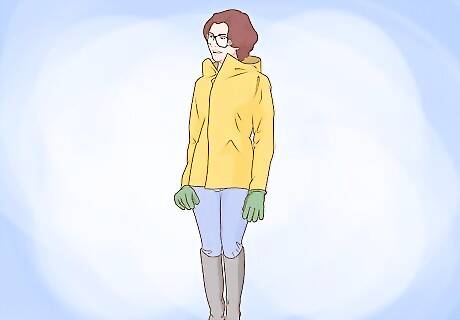
Put thick clothes, gloves, and goggles on before starting the job. Bramble bushes are covered in thorns and you could get a serious cut if you do this job without protection. Cover all of your exposed skin with long sleeves and pants. Pull your socks up high so no pieces get into your shoes. Then put on goggles and a heavy pair of work gloves. Wear high-quality work gloves for this job. Don’t use rubber or light fabric gloves. The thorns will go right through these. If you suffer from asthma or allergies, cover your face with a dust mask. Cutting down bushes kicks up a lot of allergens that could irritate your airway.
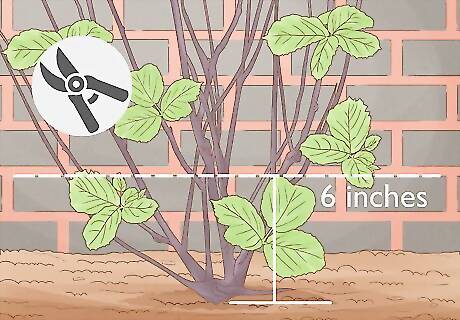
Cut the bramble vines down to 6 inches (15 cm) from the ground. A hedge trimmer or similar tool with a metal blade is best for areas covered in brambles. If you only have a small bush, then clippers will also work. Use whatever tool you have and chop down the bramble vines until they’re only 6 inches (15 cm) tall. This remaining amount makes pulling up the roots much easier. If the brambles are wrapped up with any other plants that you don’t want to cut down, be careful. Clip the vines near the base of the bramble, then work the vines out of any plants that you want to save. Be careful using any power tools. Make sure no one is around that might get hit by debris. Don’t touch the blades until the machines are safely turned off. A weed wacker or similar tool won’t work as well because the string may not pierce the brambles.
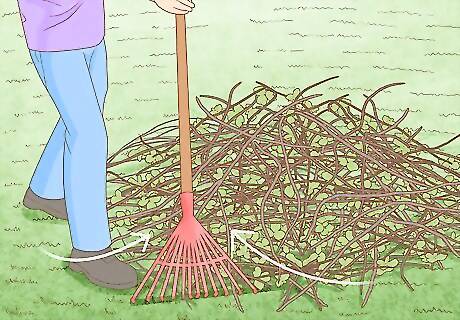
Rake up all the bramble debris from your garden. Brambles are persistent plants, and can keep growing if you leave behind any remnants on the soil. Take a heavy rake and make a pile of all the bramble pieces. Then scoop them into a garbage pail or similar container. Make sure to pick up all the debris. Especially look for any berries that fell off the plant and onto the soil. The berries contain the plant seeds, so a new bramble may start growing if there are berries in the soil.
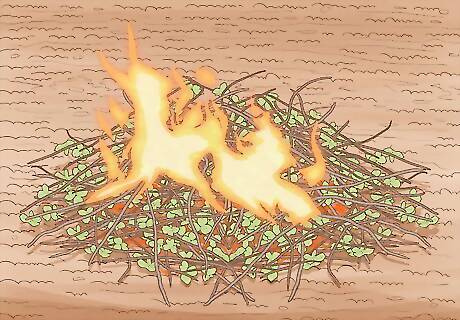
Dispose of the debris so the bush doesn’t grow back. The two recommended methods of bramble disposal are bringing them to a plant waste facility or burning them on your property. If you do burn them, make sure you do so in an open area, away from vegetation and buildings that could catch fire. Keep a hose or fire extinguisher ready in case the fire gets out of control. Otherwise, load the brambles into cans and drive them to a plant waste facility. Burning plants is illegal in some areas. Check with the laws in your locality to avoid legal trouble. Not all areas have plant waste facilities nearby. Check on the internet to see if there is one close to you. If not, then burn the brambles or throw them out with the regular garbage. Do not compost brambles. They’re too woody to give nutrients to your plants, and if they aren’t completely dried out, they could start growing again.
Removing the Roots
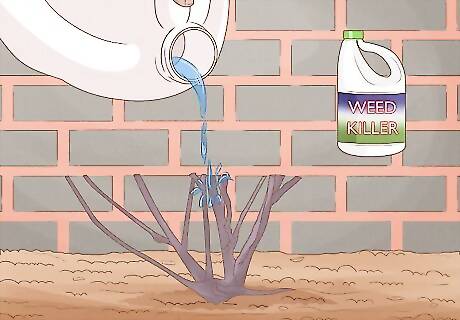
Apply weed killer to the freshly-cut plants. The best weed killers for brambles are triclopyr or glyphosate. Look for products that contain these ingredients. Then soak the entire plant down to the soil level with weed killer. Focus on spraying the newly-cut tips of the vines so the chemicals enter the plant. Apply the weed killer right after cutting the branches off. Otherwise, the opening may heal and the weed killer won’t enter the plant. The main difference between triclopyr and glyphosate is that triclopyr won’t kill other plants, but you won’t be able to plant on that area for several months, while glyphosate kills almost all other plants, but you can replant on the area shortly after applying it. Choose a product that suits your needs best. Always follow the application instructions on the product packaging. Please note: The WHO considers glyphosate to be a probable human carcinogen. Its use is prohibited in some states and countries. Please check with your local laws and use caution if handling this chemical.
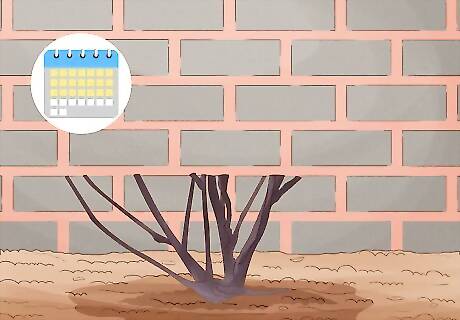
Let the weed killer soak into the plants for 1-3 weeks. During that time, the bramble should start dying. Monitor it daily. The branches will start turning brown and shriveling. When all the visible parts are shriveled and brown, the plant is dead. If 1 week has gone by and the brambles don’t look shriveled at all, apply another round of weed killer.
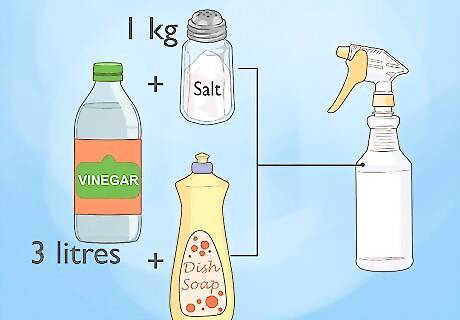
Make an organic weed killer to use on small plants. If you prefer to avoid using commercial weed killers and your brambles are small, mix up a household solution to kill the plants. Mix 3 litres (0.79 US gal) of white vinegar, 1 kg (2.2 lb) of salt, and a squeeze of dish soap. Stir the solution and load it into a sprayer. Then soak all the brambles. This method only works on smaller bramble plants. Try it out and see if it works. If you see no sign of the plant drying within a week, switch to a commercial weed killer. Even if this mixture shrivels the plant, it may not totally kill it. Be sure to dig the entire plant up, including the roots, after the plant shrivels.

Dig the roots up to ensure the plant doesn’t grow back. Even if the bramble looks dead after a chemical treatment, it could still recover and grow back. Once the plant is shriveled, use a shovel or pickaxe and dig it out of the ground. Pull up the roots, then check the hole for any remnants of the plant. Pick these up as well, then dispose of the roots along with the vines. If you want to avoid using chemicals at all, you can dig up the roots right after cutting the bushes down. This is a lot of work while the plant is still alive, but it does avoid the need for chemicals.
Keeping Your Garden Clear
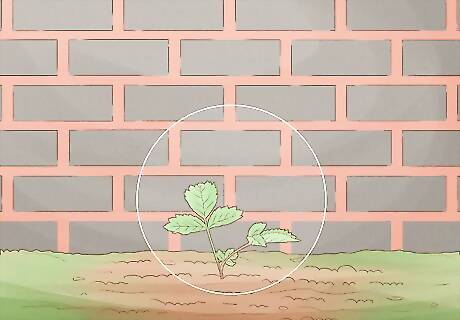
Monitor your garden and remove any small growths immediately. If brambles are native to your area, they could start growing at any time. Inspect your garden at least once a week to spot any new bramble growths. If you see any, dig them out right away, roots and all. You can also spray the vinegar/salt solution on the soil after you dig out bramble sprouts. Make sure there are no nearby plants that might get damaged if you do this.

Lay down mulch to make new growths easier to spot. Small bramble sprouts are easy to miss, and by the time you see them, they could be a pain to remove. Red mulch makes small growths much easier to see. Lay a 1–3 in (2.5–7.6 cm) mulch layer in your garden. This way, you can spot sprouts before they become a problem.
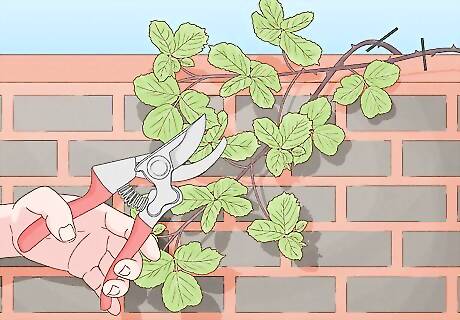
Cut away vines that enter your garden from beyond your property. If your neighbor has a bramble problem and doesn’t take care of it, these growths can stretch onto your property. Unfortunately, you can’t do anything about the main plant, so monitor your property line closely and cut any vines that stretch onto your side. Clean up any berries and remnants after you cut so the plants don’t start growing. In the meantime, you could speak with your neighbor about removing their brambles. They may not be aware that the brambles care causing trouble for you. Do not go onto someone else’s property to cut their brambles. You can only legally cut what’s on your property.

















Comments
0 comment